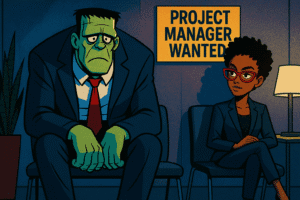In today’s dynamic business environment, having the flexibility to manage projects in different ways is a crucial skill. For me, it has been a necessity. Throughout my career, I’ve managed all types of projects such as software development and IT, process improvement, product development, IoT, office moves, and others. I’ve had to lead different types of teams, some more skilled than others. And I’ve had access to huge enterprise project management tools and other times, I had to create my own system using the software the client already had licensed – typically Microsoft Office. Rather than being a loyalist to just one project management style, I believe that managers and teams should have a toolbox of approaches they can pull from as needed. Being equipped with traditional waterfall, agile frameworks as well as hybrid methods provides essential versatility to tackle all types of projects.
The Changing Nature of Work Calls for Adaptability
The pace of business moves faster every year. Technologies, markets, and consumer preferences are always shifting. Requirements for projects undergo near-constant change even for projects already underway. What worked yesterday may not work tomorrow. This filters down into how organizations manage projects in several key ways:
Speed and Agility Are Mandatory
The accelerating tempo of business means projects must deliver value faster. Teams must adapt quickly to keep up. Long, sequential, waterfall projects stretching over months or years can\’t respond to changes in marketplace needs. This causes greater momentum toward agile, iterative approaches.
Requirements Change
The era of perfectly defining project requirements upfront is ending. Did we EVER do it perfectly though? I mean, really?? Anyway, the reality is that priorities and desired outcomes morph due to internal and external influences. Clients change their minds. New technologies emerge. Any project manager clinging rigidly to original requirements will deliver obsolete or inadequate solutions. Adaptability to handle shifting needs is essential.
More Project Varieties Than Ever
From major multi-year infrastructure builds to simple two-week application enhancements, project managers face ever-expanding project types. Enterprise Agile transitions stand apart from AI and machine learning projects. Project diversity is increasing, from sizable enterprise transformations to highly technical AI implementations. And these expanded varieties of projects have unique needs, constraints and challenges. This growth in project diversity requires fluency in different management approaches. No one-size-fits-all solution can handle such variety.
Understanding different methodologies and synthesizing approaches for each project is vital to thrive. The costs of rigidity and status quo bias grow by the year. Project leaders must have an adaptive toolkit to navigate whatever comes next.
Benefits of Understanding Multiple PM Methodologies
The true power of versatility lies in the ability to tailor the approach to the unique size, scope, and needs of a project. While traditional waterfall methods offer predictability through sequential stages, agile frameworks provide the nimble flexibility needed for iterative projects. Hybrid models, blending the strengths of both methodologies, become an extraordinarily potent strategy – offering a structured yet adaptive path to project success.
Fit Approach to Project Scale and Velocity
For massive, multi-year infrastructure projects with extensive upfront planning requirements, more predictive waterfall techniques excel. However, for rapidly changing software systems with shifitng user needs, agile is advantageous. The key is aligning methodology choice to the size and speed of change each project faces.
Leverage the Strengths of Each Approach
Even agile teams can benefit from incorporating high-level upfront project charters, communication plans, and risk management strategies. (Did I hear a Scrummaster’s head explode?) These help provide stakeholder alignment and transparency. On the other hand, traditionally managed waterfall initiatives can build in stage gates, retrospectives and continuous improvement loops to course correct. Picking the right blend is made possible by understanding multiple frameworks. I’ve been lucky enough to work in environments that did not constrain me to a pre-defined, cookie-cutter way of managing projects. I was always able to use my own judgement in how the project should be run.
Hybrid Techniques Combine Best of Both Worlds
The real power comes from weaving adaptive, iterative agile delivery with just enough big-picture planning and structure. Hybrid models do just this – providing the needed guardrails and visibility without sacrificing responsiveness. We will delve into real hybrid examples where this tailored versatility proved instrumental in project success.
The key insight is that no single methodology holds a monopoly on effectiveness – each has context-specific strengths. By understanding these nuances, today\’s project managers can synthesize the optimal approach.
Why Rigid Loyalty to One Approach Limits Effectiveness

Exclusivity to a single project management methodology can act as a bottleneck, constraining the adaptability necessary for diverse project landscapes. Waterfall, for instance, may struggle to keep pace with the demands of iterative projects, while a purely agile approach might lack the necessary structural framework for certain endeavors. Acknowledging the constraints of each method is the first step toward building a more effective toolkit.
Waterfall’s Predictive Approach Hits Speed Bumps With Change
Sticking to predictive sequential plans set at a project\’s outset restricts the ability to incorporate lessons and changing needs once delivery work kicks off. Yeah, it’s nice to say, “here is the plan, chiseled in stone, just follow it step-by-step” and nothing changes throughout the rest of the project. When has that ever really happened? Requirements validation happens early which can lead to misalignment with what users actually wanted. The bureaucracy of change control in pure waterfall makes iterating painful. Let’s face it, bureaucracy makes everything painful!
Agile’s Adaptability Can Lack Big Picture Perspective
While agile frameworks promote responding to changing priorities within a single product or project, they rarely coordinate workflows spanning multiple projects at the program or portfolio level. Agile teams rightly focus on continuous delivery of working software for their stakeholders and users. However, this hyper-focus on the immediate project can lead to fragmented, duplicated efforts or strategic misalignments between teams. Some higher-level road-mapping and cross-project structures are needed to ensure the portfolio is more than just a collection of agile projects. Lack of documentation also becomes problematic for onboarding new team members.
By acknowledging neither methodology holds a monopoly on project success, managers may take the first step to fitting approach to needs rather than forcing fit. This understanding ultimately leads to versatile hybrid models.
So, being fluent in multiple project management methods is not just a valuable skill but a strategic imperative for the future. As we navigate an era where projects vary immensely, having a versatile toolkit ensures that project managers can adapt to the unique demands of each endeavor. Rigid adherence to a singular method proves short-sighted in the face of such variability. The ability to draw from a diverse set of methodologies not only future-proofs project managers but positions them as agile leaders capable of steering projects toward success in any terrain.






